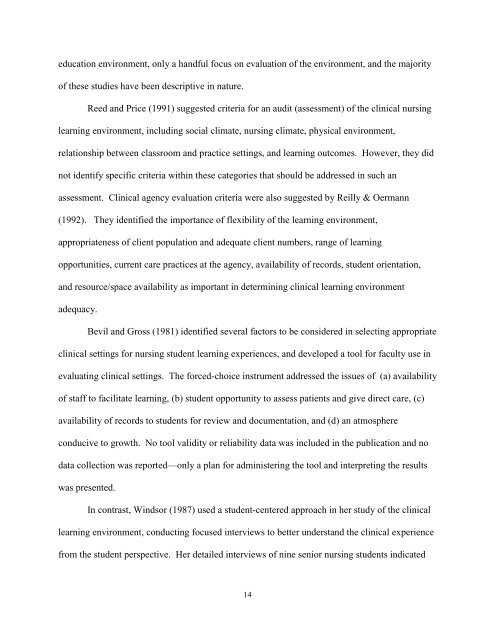STUDENT EVALUATION OF CLINICAL EDUCATION ENVIRONMENT
STUDENT EVALUATION OF CLINICAL EDUCATION ENVIRONMENT
STUDENT EVALUATION OF CLINICAL EDUCATION ENVIRONMENT
You also want an ePaper? Increase the reach of your titles
YUMPU automatically turns print PDFs into web optimized ePapers that Google loves.
education environment, only a handful focus on evaluation of the environment, and the majority<br />
of these studies have been descriptive in nature.<br />
Reed and Price (1991) suggested criteria for an audit (assessment) of the clinical nursing<br />
learning environment, including social climate, nursing climate, physical environment,<br />
relationship between classroom and practice settings, and learning outcomes. However, they did<br />
not identify specific criteria within these categories that should be addressed in such an<br />
assessment. Clinical agency evaluation criteria were also suggested by Reilly & Oermann<br />
(1992). They identified the importance of flexibility of the learning environment,<br />
appropriateness of client population and adequate client numbers, range of learning<br />
opportunities, current care practices at the agency, availability of records, student orientation,<br />
and resource/space availability as important in determining clinical learning environment<br />
adequacy.<br />
Bevil and Gross (1981) identified several factors to be considered in selecting appropriate<br />
clinical settings for nursing student learning experiences, and developed a tool for faculty use in<br />
evaluating clinical settings. The forced-choice instrument addressed the issues of (a) availability<br />
of staff to facilitate learning, (b) student opportunity to assess patients and give direct care, (c)<br />
availability of records to students for review and documentation, and (d) an atmosphere<br />
conducive to growth. No tool validity or reliability data was included in the publication and no<br />
data collection was reported—only a plan for administering the tool and interpreting the results<br />
was presented.<br />
In contrast, Windsor (1987) used a student-centered approach in her study of the clinical<br />
learning environment, conducting focused interviews to better understand the clinical experience<br />
from the student perspective. Her detailed interviews of nine senior nursing students indicated<br />
14












